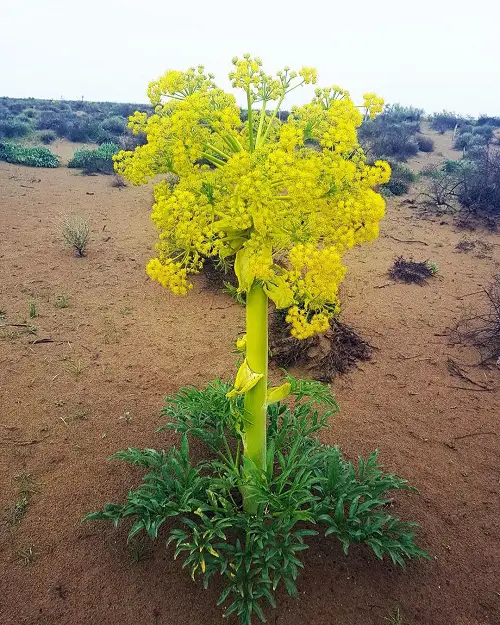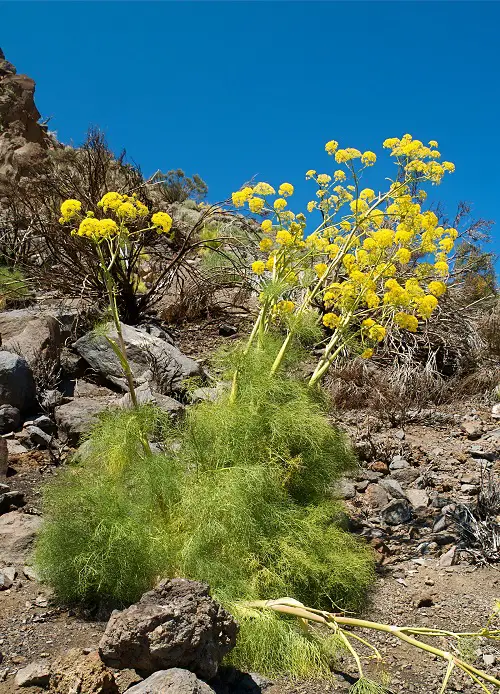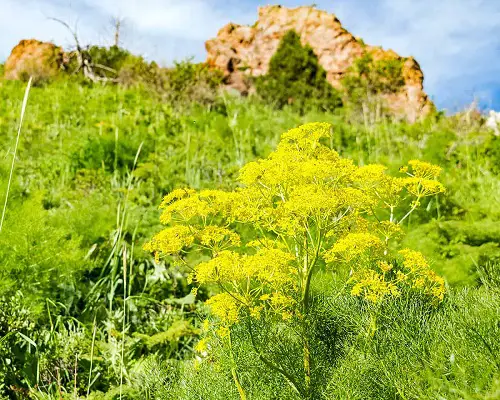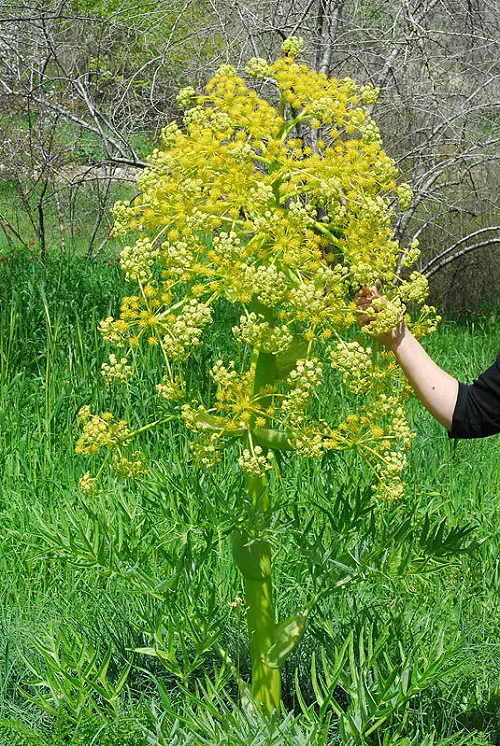Looking to add a unique and flavorful spice to your garden? Find out How to Grow Hing, popular as asafoetida, with these simple tips.

Learn How to Grow Hing Plant with the help of this detailed article, and include this flavorful spice in your garden.
Check out 15 Best Plants & Trees You Should Grow for Homemade Pickles here
What is Asafoetida?
Asafetida, or Asafoetida (Ferula foetida), has been cultivated and harvested for many centuries. This plant has garnered two opposing monikers, “Food of the Gods” and “Devil’s Dung.”
This plant originates from Afghanistan and eastern Persia, which is now Iran. It has a wide range of uses, including culinary and medicinal applications, such as a brain stimulant, laxative, and effective respiratory medicine. Asafetida grows naturally in sandy, well-drained soils and was first discovered by Western botanists in the Aral Desert. However, people have been cultivating Asafetida plants since the 12th century.
It can reach heights of 6 to 10 feet. It features several sheathed petioles and foliage that resembles parsley. The flowers are similar to those of the parsley family, forming large umbels of tiny, pale green-yellow blooms that eventually transform into flat, oval fruits. As a monocarpic plant, Asafetida takes several years to flower and then dies after flowering.
Have a look at the 18 Most Exotic Herbs Around the World
How to Grow Hing Plant?

Asafoetida is an annual plant in USDA Growing Zones 3-8 and a perennial in Zones 9-11. It is native to hot regions of the world and cannot tolerate cold temperatures.
When growing Asafoetida, it’s important to aim for a soil pH level between 6.5 to 7.5. Well-draining soil is essential for this plant to thrive, and most soil types will suffice, except for clay soils.
Asafetida seeds can be difficult to find. However, you can purchase viable seeds from online retailers. For successful growth, it is recommended to sow the seeds directly into the garden during early spring.
- To plant seeds, first, scatter them on the soil surface and lightly cover them with sandy soil. Then, press down the soil firmly.
- It’s recommended to space the seeds at a distance of around two feet to provide enough space for the tap root to grow.
- Ensure that the soil remains slightly moist until the seeds germinate. Once the plant sprouts out, water it only when the top layer of soil dries out, about an inch deep.
Note: To enhance germination rates, it’s recommended to expose the seeds to cold and moist conditions.
Companion Planting for Asafoetida
There are many plant options to grow alongside asafetida, provided it’s adequately spaced. It’s advisable to place shorter plants in front of the taller asafoetida. A few good companions for Asafoetida are:
- Lavender: Dislikes waterlogged soil and is another plant that can thrive when grown close to asafetida.
- Oregano: This is another herb that doesn’t require much water, and it’s one of my favorite hardy herbs that’s difficult to kill.
- Fennel: It can grow up to four feet tall, making it an excellent option to plant in front of Asafetida. Additionally, it won’t disturb the roots of the asafetida, and if allowed to go to seed, it will self-sow each year.
- Lemon Verbena: Being a tropical herb, it thrives well alongside asafetida.
- Lovage: It is an ideal plant to grow with asafetida, as it can grow up to several feet tall and matches the height of asafetida.
- Sweet Marjoram: Pairs well with asafetida, as it prefers sandy soil and dislikes cold weather.
Requirements for Growing Hing

Sunlight
Asafoetida is a hardy perennial plant that prefers a sunny, dry location in the garden. It will tolerate some partial shade, but it needs at least 6 hours of direct sunlight each day to thrive. Avoid growing hing in a shady area.
Soil
To grow hing, a mix of equal parts of garden soil and compost would be ideal. The soil should also be slightly acidic, with a pH of 6.5 to 7.5. Adding some sand to the soil can help improve drainage.
Water
Asafoetida is a drought-tolerant plant and does not require much water. It should only be watered when the soil has completely dried out. When it is time to water, the soil should be thoroughly moistened.
Do not over-water, as the plant is prone to root rot.
Asafoetida Care
Fertilizer
To grow hing, it’s recommended to add a handful of well-rotted manure or compost at the time of planting the seeds.
At the start of the following season, use a balanced liquid fertlizer, diluted to half of its strength, once in 3-4 weeks.
If you notice any signs of struggle, such as slow or stunted growth or yellowing leaves, you can try using tomato plant liquid fertilizer once in 4-5 weeks.
Staking
It’s important to monitor the growth of Asafetida and determine whether staking is necessary. If you live in a windy area, it’s advisable to stake the plant to give it time to develop its deep taproot.
To simplify the process, you can place a tomato cage around the plant when planting the seeds. This will provide support for the plant as it grows and help it to grow up and through the cage.
Pests and Diseases
While asafetida is generally a hardy plant, it can be vulnerable to certain pests, affecting its relative, the carrot.
- One such pest is the wireworm, which can damage the roots, stems, and seedlings of the plant, particularly when converting a grassy area to a garden. To combat wireworms, a neem oil soil drench can be used, especially when first converting the land to a garden. This can help to prevent wireworms from damaging the asafetida and other plants in the garden.
- As asafetida plants mature, they become less attractive to slugs and snails. However, when they are young seedlings, they may be vulnerable to these pests. To protect the seedlings, slug pellets can be used when planting the seeds and when the seedlings emerge. This can help to prevent slugs and snails from eating the young plants and ensure that they have a chance to grow and mature.
- Flea beetles can cause significant damage to an asafetida plant, especially during the spring and summer months. These pests feed on the leaves, while the larvae feed on the roots. If left unchecked, flea beetles can ultimately kill an asafetida plant.
Harvesting Asafoetida
The process of harvesting asafoetida involves digging up the roots of the plant, cleaning them, and drying them in the sun. Once dry, the roots are then ground into a powder and sold in stores. The powder can then be used to add flavor to a variety of dishes.
For culinary purposes, harvest asafetida shoots and leaves when they are young and tender. To prepare the young leaves and shoots of asafetida, harvest and boil them for a few minutes until the smell dissipates. Then, fry them in a small amount of salt and butter along with the roots.
To obtain the gum resin, incisions are made in the roots and rhizomes of plants. When the surface is cut, a juice exudes, which coagulates upon exposure to air. After a few days, the gum-resin exudate is scraped off.
Processing Asafoetida
After the juice is extracted from the asafetida root, it dries into a brown, resinous substance. Asafetida is commonly sold in either lump or powdered form, with the former being the purest.
The pure resin is either traded alone or as a “compounded asafoetida,” which is a powder consisting of over 50% rice flour to prevent clumping. Additionally, the gum resin can be steam distilled to extract the essential oil known as the oil of Asafoetida.
Asafoetida Uses
- As a food flavoring and medicinal spice, asafoetida has been used for a long time. It is highly regarded for its ability to treat certain nervous conditions, such as hysteria, as well as respiratory problems like bronchitis, asthma, and whooping cough.
- Asafoetida has properties that help relieve flatulence and treat spasmodic disorders. Additionally, it is known as a nervine stimulant, digestive aid, and sedative.
- The gum resin of asafoetida is said to possess antispasmodic, carminative, expectorant, laxative, and sedative properties. It contains a volatile oil that can be beneficial for treating asthma by aiding the elimination of mucus through the lungs.
Note: Due to its properties as a blood thinner and endocrine disruptor, asafoetida can be potentially dangerous for pregnant women.




